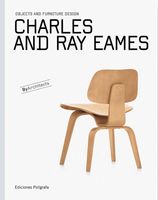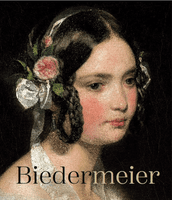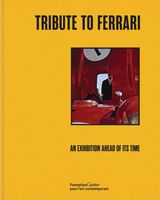| | BOOK FORMAT
Hardcover, 6.5 x 8.25 in. / 128 pgs / 220 color. PUBLISHING STATUS
Pub Date 11/1/2007
Out of print DISTRIBUTION
D.A.P. Exclusive
Catalog: FALL 2007 p. 35 PRODUCT DETAILS
ISBN 9788434311435 TRADE
List Price: $30.00 CAD $40.00 AVAILABILITY
Not available | TERRITORY
NA Japan | | THE FALL 2025 ARTBOOK | D.A.P. CATALOG  | | Preview our FALL 2025 catalog, featuring more than 500 new books on art, photography, design, architecture, film, music and visual culture.
|
| | | Alvar Aalto: Objects and Furniture Design By ArchitectsEdited by Patricia de Muga. Texts by Sandra Dachs, Laura García Hintze. Introduction by Markku Lahti.
Alvar Aalto (1898-1976) is the most prestigious Finnish architect of the last century, and the father of Nordic Modernism. He once said, "God created paper for the purpose of drawing architecture on it. Everything else is at least for me an abuse of paper." In the U.S. Aalto's critical reception began with his design for the Finnish Pavilion at the 1939 World Fair in New York: Frank Lloyd Wright described it as a "work of genius." After World War II, Aalto also designed MIT's student dormitory. Prior to this, the architect's Paimio Sanatorium (1929) and Viipuri Library (1935), both in Finland, had already attracted international praise. He was also an outstanding town planner, painter and sculptor. Aalto's Modernism entailed the use of natural materials, warm colors, and undulating lines, and he is considered an important early exponent of Organic Design as a result. Of his design work outside of architecture, Aalto's vases, lamps, glassware and laminated bent-plywood furniture (pioneered and produced through the design company he co-founded, Artek) are equally esteemed. Iconic pieces include the Savoy Vase, the Paimio Chair and the Beehive Lamp. This monograph on Aalto's highly collectible furniture designs expands our understanding of the diverse abilities of this influential architect/designer.
|
| | | | |  | PolígrafaISBN: 9788434314955
USD $30.00 | CAD $40Pub Date: 12/24/2024
Active | In stock
|
|  | PolígrafaISBN: 9788434314962
USD $30.00 | CAD $40Pub Date: 12/24/2024
Active | In stock
|
|  | PolígrafaISBN: 9788434314948
USD $35.00 | CAD $49Pub Date: 12/24/2024
Active | In stock
|
|  | Ediciones PolígrafaISBN: 9788434312654
USD $30.00 | CAD $40Pub Date: 4/30/2013
Out of print | Not available
|
|  | Ediciones PolígrafaISBN: 9788434312647
USD $30.00 | CAD $40Pub Date: 4/30/2013
Out of print | Not available
|
|  | Ediciones PolígrafaISBN: 9788434311435
USD $30.00 | CAD $40Pub Date: 11/1/2007
Out of print | Not available
|
|  | Ediciones PolígrafaISBN: 9788434311442
USD $30.00 | CAD $40Pub Date: 11/1/2007
Out of print | Not available
|
|  | Ediciones PolígrafaISBN: 9788434311459
USD $30.00 | CAD $40Pub Date: 10/26/2007
Out of print | Not available
|
|  | Ediciones PolígrafaISBN: 9788434311848
USD $30.00 | CAD $40Pub Date: 9/30/2010
Out of print | Not available
|
|  | PolígrafaISBN: 9788434311824
USD $30.00 | CAD $40Pub Date: 9/30/2010
Active | In stock
|
|
| OF RELATED INTEREST |  | The Museum of Modern Art, New YorkISBN: 9780870701078
USD $50.00 | CAD $60Pub Date: 7/2/2002
Out of print | Not available
|
|  | Edizioni CorrainiISBN: 9788887942026
USD $24.95 | CAD $27.5Pub Date: 3/2/2001
Out of print | Not available
|
|
| FORTHCOMING AND NEW: DESIGN AND DECORATIVE ARTS |  | Walther König, KölnISBN: 9783753308159
USD $55.00 | CAD $83.5Pub Date: 12/9/2025
Active | In stock
|
|  | Silvana EditorialeISBN: 9788836660698
USD $45.00 | CAD $64Pub Date: 11/11/2025
Active | In stock
|
|  | Verlag für moderne KunstISBN: 9783991531432
USD $45.00 | CAD $64Pub Date: 7/1/2025
Active | In stock
|
|  | Marsilio ArteISBN: 9791254632994
USD $50.00 | CAD $78 UK £ 43Pub Date: 12/16/2025
Active | In stock
|
|  | Lars Müller PublishersISBN: 9783037787816
USD $60.00 | CAD $85Pub Date: 7/1/2025
Active | In stock
|
|  | Lars Müller PublishersISBN: 9783037787922
USD $50.00 | CAD $70Pub Date: 1/13/2026
Forthcoming
|
|  | Hatje CantzISBN: 9783775759977
USD $75.00 | CAD $105Pub Date: 7/29/2025
Active | Out of stock
|
|  | Fondation Cartier pour l'art contemporainISBN: 9782869251922
USD $75.00 | CAD $90Pub Date: 1/13/2026
Forthcoming
|
|  | Éditions DilectaISBN: 9782373722246
USD $50.00 | CAD $70 UK £ 40Pub Date: 2/10/2026
Forthcoming
|
|  | Strandberg PublishingISBN: 9788794418676
USD $50.00 | CAD $70Pub Date: 8/26/2025
Active | In stock
|
|  | nai010 PublishersISBN: 9789462088627
USD $35.00 | CAD $53Pub Date: 2/11/2025
Active | Out of stock
|
|  | Lars Müller PublishersISBN: 9783037787786
USD $25.00 | CAD $38Pub Date: 1/7/2025
Active | In stock
|
|
|
| |